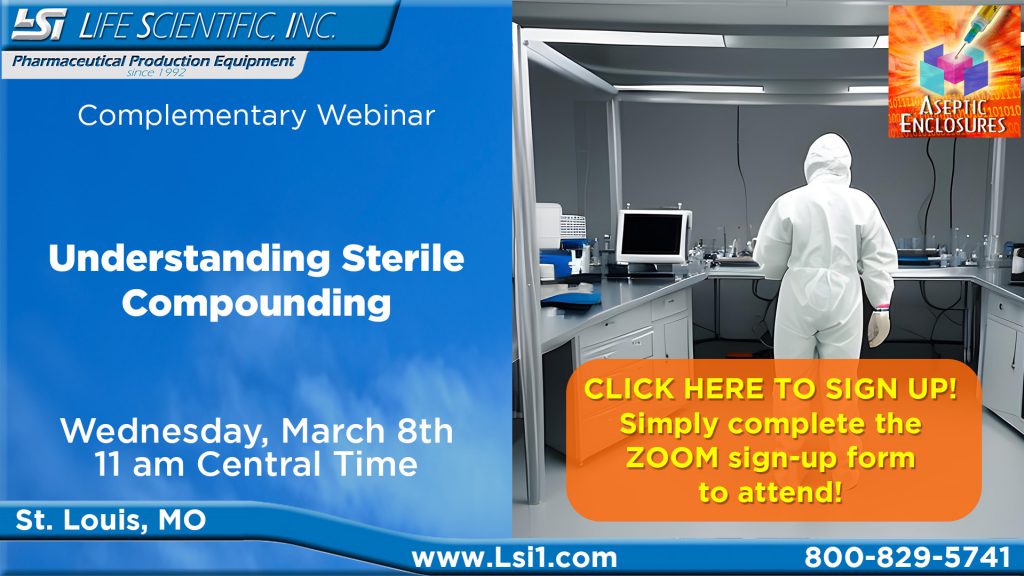
Compounding pharmacies come in many different shapes and sizes. They can consist of a pharmacist creating a drug under a doctor’s prescription or they can be pharmacy-type facilities that compound drugs and sell them like a manufacturer. Sporadic and serious infection outbreaks have been linked to compounding pharmacies outside of the hospital setting.1 These problems date back to as early as 1976.2 Despite attempts by the United States Pharmacopeia (USP) to make compounding safer, problems still occur.
503B compounding pharmacies are required to adhere to the same microbial regulations and expectations as aseptic pharmaceutical manufacturers. The FDA recommends that compounding facilities that produce sterile drugs routinely perform the following:
- Environmental monitoring, including nonviable airborne particulate sampling, viable airborne particulate sampling, personnel sampling (including glove fingertip sampling), surface sampling (including but not limited to equipment, work surfaces, and room surfaces)4
- Media fill studies mimicking aseptic production operations4
- Certify the ISO 5 area every six months, including smoke studies.4
- Measure pressure differentials between the different adjacent classified areas.4
Contamination prevention should be thought of in a holistic manner, from the beginning to the end of the process, because microorganisms are present in most habitats. This includes items like supplier management, shipping and receiving, sampling and testing of components and raw materials, facility design, personnel, and environmental and utility monitoring. One cannot rely on the sterility test alone as it does not verify an entire lot of product is sterile. Sterility assurance needs to be built into the manufacturing process.
Humans are the primary source of contamination in a cleanroom. Other common sources include the air, surfaces, and water. Microorganisms may be transferred directly (e.g., touching a surface with a contaminated object) or indirectly (e.g., distributed through the air).5 Monitoring for microbial contamination and identifying any recovered isolates can help detect contamination sources and establish any corrective actions.
Proper design of facilities also helps control microbial contamination. Regulatory requirements for facility design and cleanroom classifications are found in multiple guidance documents, including the Annex 16 and the Code of Federal Regulations (CFR).7 These regulations require certain cleanliness levels in the state of operation, adequate space, and proper material/personnel flow to prevent contamination or mix-ups. Furthermore, 21 CFR 211.42 requires the following regarding facility design for aseptic processing:
- Floors, walls, and ceilings of smooth, hard surfaces that are easily cleanable;
- Temperature and humidity controls;
- An air supply filtered through high-efficiency particulate air filters under positive pressure, regardless of whether flow is laminar or nonlaminar;
- A system for monitoring environmental conditions;
- A system for cleaning and disinfecting the room and equipment to produce aseptic conditions;
- A system for maintaining any equipment used to control the aseptic conditions.3
There are different classifications of cleanrooms. Annex 1 uses grades, i.e., Grade A, Grade B, Grade C, and Grade D. Grade A is considered the cleanest area.1 ISO 14644-1 uses a similar gradient (ISO 5, ISO 6, ISO 7, and ISO 8), where the ISO 5 area is the cleanest classified area.8
Within the cleanrooms, high-efficiency particulate air (HEPA) filters are used to treat the air to decrease the potential of microbial and particulate contamination. If the HEPA filters are leaking or the filters and/or the returns are blocked, the HEPA filters will not function as intended. Air pressure or air exchange rates need to increase as the cleanroom classifications increase. This means that the inner core (ISO 5/Grade A areas) should have the highest number of air exchanges and the highest air pressure when compared to the surrounding areas. Positive air pressure cascades help to keep microbial ingress under control.
Currently, we have approximately 20 contamination preventative jobs in-house, and we have performed several hundred similar projects since launching the Aseptic Enclosures division in 2005.
We are contracted with several GPOs providing the most competitive pricing on the market, please do not hesitate to get in touch and request a preliminary meeting.
Typically, by us getting involved in jobs early, we can save facilities a tremendous amount of professional fees, overall project cost, and long-term operational costs.
Aseptic Enclosures first entered into this segment back in 2005 and has been gaining extensive experience with every challenge we are faced with. Please contact us at 1-800-418-9289 and let us know how we can help!


Thanks for explaining the expectations for aseptic pharmaceutical manufacturers. Now that I think about it, I’d like to learn how these expectations have changed over time. I appreciate you sharing this info about preventing contamination.